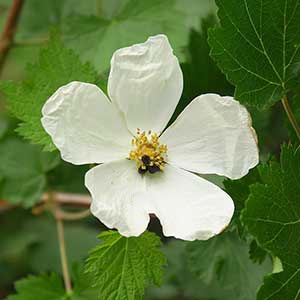Rubus bartonianus
Rubus caesius
Barton's raspberry, bartonberry
European dewberry
erect, sparsely short-hairy, glabrescent, eglandular, not pruinose.
biennial, creeping or arching then creeping, glabrous or hairy, eglandular or sparsely sessile- to short-stipitate-glandular, strongly pruinose;
prickles sparse to dense, erect to retrorse, slender, 1–3 mm, narrow- or broad-based.
deciduous, simple;
stipules lanceolate, 4–6 mm;
blade cordate to broadly ovate, (2–)2.5–4(–5) × (2.5–)3.5–4.5(–5.5) cm, base deeply cordate, 3–5-lobed, lobe apices acute to obtuse, margins coarsely doubly dentate, abaxial surfaces glabrous or sparsely hairy, eglandular or sparsely stipitate-glandular.
deciduous, ternate;
stipules linear-lanceolate to ovate, 5–15 mm;
terminal leaflets ovate, 4–14 × 3–10 cm, base rounded to shallowly cordate, unlobed or shallowly lobed, margins coarsely serrate to doubly serrate, apex acute to acuminate, abaxial surfaces with prickles on midveins or unarmed, sparsely to moderately hairy, eglandular or sparsely short-stipitate-glandular along larger veins.
1-flowered.
terminal on short shoot, usually appearing axillary, 1–6-flowered, solitary flowers, cymiform, or racemiform.
moderately hairy, eglandular or sparsely stipitate-glandular.
unarmed or prickles sparse to dense, erect to retrorse, densely hairy, sparsely to densely sessile- to short- or long-stipitate-glandular.
bisexual;
petals white, obovate, (15–)20–25 mm;
filaments filiform;
ovaries glabrous, styles clavate, villous.
bisexual;
petals white, obovate to elliptic or suborbiculate, 7–13 mm;
filaments filiform;
ovaries glabrous.
deep red, hemispheric, to 1 cm;
drupelets 10–30, coherent, separating from torus.
appearing bluish, black beneath bloom, pruinose, globose, 0.5–1.5 cm;
drupelets 1–5(–20), weakly coherent, separating with torus attached.
= 28.
Rubus bartonianus
Rubus caesius
Of conservation concern.
Rubus bartonianus is distinguished from the other flowering raspberries within its geographic range by its erect, unarmed stems, relatively small, simple leaves with acute to obtuse lobes, deeply cordate bases, sparsely hairy or glabrous abaxial surfaces, relatively large flowers with white petals, and densely long-hairy, clavate styles. The leaves superficially resemble those of Acer glabrum or some species of Ribes.
Rubus bartonianus is most similar to R. neomexicanus but especially R. deliciosus. The species is known only from the Snake River Canyon of Idaho and Oregon.
(Discussion copyrighted by Flora of North America; reprinted with permission.)
Within the flora area, Rubus caesius usually produces fruit with few, relatively large drupelets; in Eurasia, fruit with more drupelets are typical, and weakly pruinose fruit have been observed.
Rubus caesius is vegetatively similar to R. flagellaris and is introduced into parts of the geographic range of the latter; see M. P. Widrlechner (1998) for a comparison of these two species. Rubus caesius shows striking vegetative similarity to pruinose, trifoliate-leaved plants of R. ursinus, with which it may have a close relationship (L. A. Alice, unpubl.). In the absence of flowers or fruit, these two species could be mistaken for one another. Rubus caesius generally has broader middle primocane leaflets than R. ursinus, but that is not a consistent difference. Rubus caesius may have been introduced into the geographic range of R. ursinus; most herbarium specimens surveyed have been inadequate to make a proper determination. On specimen labels, herbarium collectors should describe at least the color of the fruit. In the last decade, R. caesius apparently has become much more aggressive around Ithaca, New York, despite occurring there since the early twentieth century (F. R. Wesley, pers. comm.).
(Discussion copyrighted by Flora of North America; reprinted with permission.)


